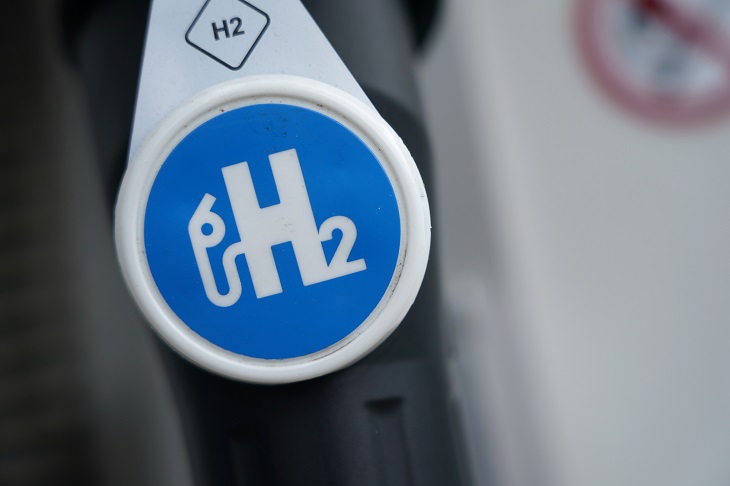Whenever the word ‘hydrogen’ surfaces in discussions about a future energy mix, my climate-sceptic Australian friends clam up. Though a climate sceptic myself and far from being an expert on the physics and chemistry of fuel cells and electrolysis, I have quietly kept an eye on the possible roles of hydrogen as a carrier of energy and an environment-friendly source of heat and electricity. My interest probably stems from my teenage years, when my father was involved in developing novel electrolytic processes in German industry and I was given a battery-operated toy kit with which I could coat nails and other bits of metal with a thin layer of copper. My career ended abruptly when I copper-coated my mother’s nail files and house keys.
The inverse of electrolysis – where a direct electric current splits water into oxygen and hydrogen – occurs in fuel cells. Here, manufactured and transportable H2 is combined with oxygen from the air to generate a steady flow of electricity, drops of harmless water (H2O), and – like all burning processes – minute quantities of noxious nitric oxide (NOx). As governments increasingly mandate hasty and costly changes to our traditional reliance on coal, oil, and gas – still the most reliable and least costly sources of energy – the fuel-cell process has enormous theoretical appeal. If the technical challenges of producing, storing, and transporting hydrogen gas can be solved, it would help us with transport, keeping ourselves comfortable, and lighting the nights.
I am, of course, fully aware of the spectacular flare-up of the hydrogen-lifted Hindenburg Zeppelin in 1937. I am also aware that, a few decades back, starry-eyed developments of fuel-cell propulsion in the German car industry came to naught. They were dropped when sceptics simulated a head-on collision of two hydrogen-propelled motor cars at motorway speed. The storage of compressed hydrogen – more precisely H2 – in the tank of a limousine, even when contained in a sponge of metallic mesh, proved anything but safe. No one wanted to risk a Hindenburg moment on a German autobahn.
The production and storage of hydrogen gas of course requires huge amounts of energy. But if energy could be collected en masse and made safe and economical, this would overcome the huge problem of how to store energy flowing intermittently from wind, sunshine, and tidal movement. As we know, short-lived conventional batteries – even mega investments in costly schemes such as Australia’s troubled Snowy 2.0 – cannot bridge regular wind draughts or propel cars reliably over reasonable distances.
Fuel cells are old technology. The science behind them was discovered piecemeal in the 17th to 19th centuries by the greats of the scientific revolution: Robert Boyle, Antoine-Laurent de Lavoisier, Luigi Galvani, Alessandro Volta, Michael Faraday, Charles Martin Hall, and Paul Héroult among others. In 1806-7, François Isaac de Rivaz built the first fuel cell to propel a vehicle. The fuel cell was invented again and perfected in 1839 by British engineer Robert Grove, when he produced electricity from hydrogen and oxygen. He inspired French visionary Jules Verne to rave about this invention which, Verne asserted, would make ‘water the coal of the future’. Nowadays, fuel cells are in wide use in industry to produce gasses and synthetic compounds.
The two major problems for fuel-cell technology are how to obtain hydrogen economically and how to store and transport it safely. If one puts natural gas, methanol, or biogas under enormous pressure, one can obtain pure hydrogen. But this process of course draws on fossil resources and produces ‘dreaded’ CO2 emissions. In the petrochemical industry, hydrogen is often a by-product of electrolysis; the gas is then normally used in other production processes within the same plant. To date, ‘green hydrogen’, produced with wind or solar-generated electricity – Jules Verne’s ‘coal of the future’ – is so far no more than a niche product. But that may change soon.
The promise of hydrogen as a potent energy carrier keeps tempting scientists, engineers, and entrepreneurs. Inspired dreamers have not given up on imagining a ‘clean’ future powered by hydrogen from giant solar and wind farms. Many are hell-bent on solving the manifold, intractable problems with the use of hydrogen, as they see great commercial promise. In 2006, the US National Renewable Energy Laboratory estimated that 1 kg of hydrogen (roughly equivalent in energy terms to 4 litres of petroleum) could be produced by wind-driven electrolysis for between US$5.55 in the near-term future and maybe US$2.27 in the long term. I have even met someone who was looking into the tidal powers on the Kimberley coast in Australia’s Northwest to produce clean hydrogen for electricity generation in Shanghai, Guangzhou, or Seoul. Hydrogen can be mass-produced almost anywhere on Earth. Nations dependent on fossil-fuel imports may well try to become independent of the world’s oil and gas cartels, such as OPEC, and extortionist suppliers, such as Russia. In this context, it is interesting that the government of Dominica in the Caribbean signed an agreement in April 2023 to develop their geothermal resources to generate hydrogen.
All now points to numerous and diverse efforts to develop the old fuel-cell technology into manifold new applications. Thus, the French gas company Air Liquide, a supplier of H2 gas, is now installing the infrastructure to distribute and use it. In cooperation with major European firms – such as Daimler, OMV, Shell, and gas producer Linde – they have formed the H2 Mobility Company that is now building a network of hydrogen fuel stations across Europe. In Germany alone, one hundred are already operational, and another 300 are planned to be open by the end of 2023. In the United States, Air Products, an established producer of industrial gasses with a turnover of US $12 billion last year, has already opened 250 hydrogen service stations. This firm will also supply the European H2 Mobility Company with hydrogen produced by wind power in the Netherlands. They also partner with a Saudi Arabian enterprise to build the world’s so far biggest solar hydrogen plant in the desert to produce some 650 tons of hydrogen per day.
In the gruelling 2022 and 2023 Dakar Rallies around Saudi Arabia, we saw fuel-cell powered prototypes of heavy racing trucks. One was developed by the small, innovative French engineering company Gaussin, listed on the Paris stock exchange in the Euronext Growth index. They were sponsored by ARAMCO oil. Another was a truck built by German truck producer MAN of the Volkswagen Group, which relied on H2 from a 420-litre tank to boost the power of diesel fuel. Audi entered speedy experimental electric cars that, however, needed a supplementary petrol engine to cover the necessary distances.
It is now hotly debated whether electric cars, which are burdened with heavy battery sets, or hydrogen-powered fuel-cell cars will eventually win the race. At the Tokyo Olympics, one-hundred fuel-cell buses moved sportspeople and fans around town, a fact that was hardly noticed. Producers of heavy transport vehicles around the world are now betting on fuel-cell technology. The list of big investors includes a cooperative venture between Toyota and US truck producer Kenworth, Hyundai of South Korea, and Iveco (an Italian, French, and German truck builder), who cooperates with the electronics gurus at the Bosch company. The American engine producer Cummins has recently bought up Canadian fuel-cell pioneers and joined the World Hydrogen Council, formed by some 130 corporations from around the world to realise the long-term vision of a hydrogen economy. Then, there are specialist companies, such as Worthington Industries of Columbus, Ohio who have developed a new high-pressure hydrogen tank called ThermaGuard. It looks to me likely that fuel cells will before long change heavy transport on the road, on rail, and in ships.
There is also much excitement among techno-economic analysts about stationary fuel cells. In several countries, pioneers are engaged in pilot projects that rely on the intensive heat from hydrogen-oxygen fusion to make steel, cement, and glass. And in Japan, some 300,000 private homes now get their heat and electricity from small, in-house fuel cells. The 2021 Tokyo Olympic Games were an opportunity for Japan to highlight the country’s hydrogen prowess. The Olympic village was powered by ‘cold burning’, i.e. a process in which natural gas generates hydrogen, which in turn produces heat and electricity. The firm Panasonic has lately become a hydrogen pioneer. They market small fuel-cell heaters for the cellar or the garage of individual homes. For now, small, stationary fuel-cell heaters are too expensive to instal in private homes. In Japan and Germany, they are bought only because they are heavily subsidised. Over the longer term, time and markets will decide whether such private ‘mini power stations’ have a future.
The South Korean Hyundai Group is now involved in ambitious projects to produce seven new vehicles driven by electric batteries and ten by fuel cells, mostly for heavy transport. This is coupled with installing a network of hydrogen outlets through a new company called Hyundai Hydrogen Mobility. Although the number of roadside hydrogen service stations – presently 213 – lags behind ambitious official targets, Korean planners are still looking to a massive expansion of fuel-cell use. They see Australia as the major future supplier of H2. Hyundai will sell their technology to their competitors to ensure economies of scale, partly to overcome the notorious chicken-and-egg problem, which is whether to build distribution networks ahead of demand, or stifle demand by a lack of outlets? Countries as disparate as India, a potential major consumer, and Qatar, a potential major supplier of H2 (or ammonia to create H2) are gearing up for major breakthroughs in fuel-cell technology. Some observers of the huge Chinese market for trucks and cars predict that China will – thanks to government preferment – swing decisively in the direction of fuel-cell propulsion, sidelining electric vehicles.
Some observers assert that, in one-hundred years, electric battery cars will be thought of as a temporary aberration – just as we are now thinking about steam-engine-propelled ‘horseless coaches’. Let us not forget that experts praised steam vehicles as the most likely future of auto-mobility when people rode penny-farthing bikes and a certain Carl Benz bought gasoline from apothecaries. Indeed, we may even discover in one-hundred years that the assumptions of most climate modellers, which UN and government officials now accept without questioning, were wrong. Many may then still rely on fossil fuels without feeling guilty. Or even that civilisation will be powered by nuclear fusion.
While some of these many mobile and stationary fuel-cell applications spring at least partly from the wish to ‘milk’ government subsidies, others are motivated by purely commercial considerations. As an observant bystander, I cannot but conclude that hydrogen probably has an important role to play in a future energy mix. Admittedly, one reads at the moment a lot about frustrations, failures, delays, and side effects, but such adversities are a frequent by-product when techno-commercial breakthroughs occur.
We live at a time of massive and thrilling experimentation to find out what is technically feasible: Will it work? But more importantly, what is commercially feasible: Will it be profitable without government intervention?
It would be a shame if conservative observers, such as most of my friends, kept their minds closed to the possibilities.
Wolfgang Kasper is a Professor of Economics, emeritus, University of New South Wales, Australia.
Got something to add? Join the discussion and comment below.
Get 10 issues for just $10
Subscribe to The Spectator Australia today for the next 10 magazine issues, plus full online access, for just $10.


























Comments
Don't miss out
Join the conversation with other Spectator Australia readers. Subscribe to leave a comment.
SUBSCRIBEAlready a subscriber? Log in